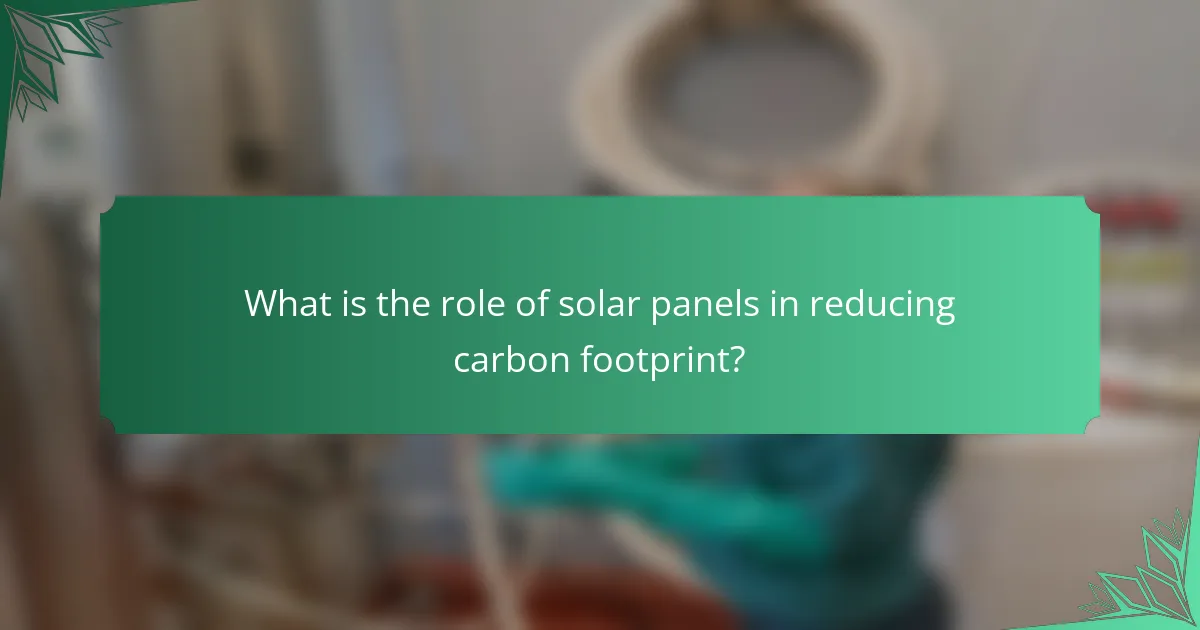
What is the role of solar panels in reducing carbon footprint?
Solar panels play a crucial role in reducing carbon footprint by generating electricity from sunlight. This process eliminates the need for fossil fuels, which are major sources of carbon emissions. According to the U.S. Environmental Protection Agency, solar energy can reduce greenhouse gas emissions significantly. In fact, a typical residential solar panel system can offset about 100 tons of carbon dioxide over its lifetime. By harnessing renewable energy, solar panels contribute to a cleaner environment. They also promote energy independence and sustainability, further decreasing reliance on carbon-intensive energy sources.
How do solar panels contribute to sustainability?
Solar panels contribute to sustainability by generating renewable energy from sunlight. This process reduces reliance on fossil fuels, which are a major source of greenhouse gas emissions. Solar energy production emits little to no carbon dioxide during operation. According to the U.S. Department of Energy, solar power can reduce carbon emissions by approximately 80% compared to coal. Additionally, solar panels can be installed on existing structures, minimizing land use impacts. Their long lifespan of 25 years or more ensures prolonged energy generation with low environmental impact. Furthermore, solar technology continues to improve, enhancing efficiency and reducing waste. These factors collectively support a sustainable energy future.
What are the key mechanisms by which solar panels reduce carbon emissions?
Solar panels reduce carbon emissions primarily by generating electricity from sunlight instead of fossil fuels. This process eliminates the need for coal, oil, or natural gas, which are significant sources of carbon dioxide emissions. When solar panels convert sunlight into electricity, they produce no direct emissions. According to the U.S. Department of Energy, solar energy systems can offset approximately 80% of greenhouse gas emissions compared to conventional energy sources. Additionally, solar panels contribute to a decentralized energy grid, which reduces transmission losses and further minimizes emissions. By reducing reliance on fossil fuels, solar panels play a crucial role in mitigating climate change and promoting sustainability.
How does the lifecycle of solar panels impact their overall carbon footprint?
The lifecycle of solar panels significantly impacts their overall carbon footprint. The production phase generates emissions due to the extraction and processing of raw materials. Manufacturing processes can emit up to 70 grams of CO2 per kilowatt-hour produced. During their operational phase, solar panels generate clean energy, reducing reliance on fossil fuels. This phase can offset emissions by approximately 80% over their lifetime. At the end of their lifecycle, recycling options can further minimize carbon impact. Proper recycling can recover up to 95% of materials, reducing waste and emissions associated with disposal. Overall, the complete lifecycle assessment shows that solar panels can lead to a net positive reduction in carbon emissions.
Why is reducing carbon footprint important?
Reducing carbon footprint is important to mitigate climate change. Carbon emissions contribute significantly to global warming. Higher temperatures lead to extreme weather events and rising sea levels. These changes threaten ecosystems and human livelihoods. Additionally, reducing carbon footprint can improve air quality. Better air quality leads to healthier communities. A lower carbon footprint also promotes sustainable resource use. Sustainable practices ensure resources are available for future generations.
What are the environmental impacts of carbon emissions?
Carbon emissions significantly contribute to climate change and global warming. They trap heat in the atmosphere, leading to rising temperatures. This phenomenon causes extreme weather events, such as hurricanes and droughts. Additionally, carbon emissions result in ocean acidification. The increase in CO2 levels affects marine ecosystems and coral reefs. Deforestation, often driven by carbon-intensive activities, reduces biodiversity. It disrupts habitats and threatens wildlife. The impacts of carbon emissions are widespread and detrimental to both the environment and human health.
How does reducing carbon footprint benefit society and the economy?
Reducing carbon footprint benefits society and the economy by promoting environmental sustainability and enhancing public health. Lower carbon emissions lead to improved air quality. This results in fewer respiratory diseases and healthcare costs. Economically, transitioning to renewable energy sources creates jobs. The solar industry alone has generated over 250,000 jobs in the U.S. since 2010. Additionally, reduced reliance on fossil fuels stabilizes energy prices. This stability encourages investment in green technologies. Overall, a lower carbon footprint fosters a healthier population and a more resilient economy.

What types of solar panels are available?
There are three main types of solar panels available: monocrystalline, polycrystalline, and thin-film. Monocrystalline panels are made from a single crystal structure. They are known for their high efficiency and space-saving design. Polycrystalline panels consist of multiple crystal structures. They are generally less efficient than monocrystalline but are more affordable. Thin-film panels are made from a variety of materials, including cadmium telluride and amorphous silicon. They are lightweight and flexible but typically have lower efficiency. Each type of solar panel has its own advantages and disadvantages. These attributes make them suitable for different applications and consumer needs.
How do different types of solar panels work?
Different types of solar panels work by converting sunlight into electricity through distinct technologies. Monocrystalline solar panels use high-purity silicon, providing higher efficiency and a longer lifespan. Polycrystalline solar panels consist of multiple silicon crystals, offering a lower cost but slightly reduced efficiency. Thin-film solar panels utilize a variety of materials, including cadmium telluride or amorphous silicon, making them lightweight and flexible but generally less efficient. Each type operates on the photovoltaic effect, where sunlight excites electrons in the semiconductor material, generating direct current (DC) electricity. This electricity can then be converted to alternating current (AC) for use in homes and businesses through an inverter. The efficiency and cost-effectiveness of each type influence their adoption in reducing carbon footprints in different applications.
What are the differences between monocrystalline and polycrystalline solar panels?
Monocrystalline solar panels are made from a single crystal structure, while polycrystalline solar panels consist of multiple crystal structures. Monocrystalline panels typically offer higher efficiency rates, often exceeding 20%. They also occupy less space for the same energy output compared to polycrystalline panels. Polycrystalline panels are generally less expensive to produce, leading to lower retail prices. However, their efficiency usually ranges from 15% to 17%. Monocrystalline panels perform better in low-light conditions. In contrast, polycrystalline panels may have a shorter lifespan due to their manufacturing process. Overall, the choice between the two depends on budget, space, and efficiency needs.
What are thin-film solar panels and their unique attributes?
Thin-film solar panels are a type of photovoltaic technology that uses layers of semiconductor materials to convert sunlight into electricity. They are characterized by their lightweight and flexible design, allowing for versatile installation options. Thin-film panels typically have a lower efficiency compared to traditional silicon-based panels, averaging around 10-12%. However, they perform better in low-light conditions and high temperatures. Unique attributes include their ability to be integrated into building materials, such as windows and roofs, and their lower production costs due to less material usage. Additionally, thin-film panels can maintain performance in partial shading situations. These attributes make thin-film solar panels a viable option for various applications, including residential and commercial buildings.
What are the benefits of using solar panels for carbon reduction?
Using solar panels significantly reduces carbon emissions. Solar energy is renewable and does not produce harmful greenhouse gases during operation. According to the U.S. Department of Energy, solar power can reduce carbon dioxide emissions by approximately 80% compared to fossil fuels. This transition to solar energy decreases reliance on coal and natural gas, which are major sources of carbon emissions. Furthermore, solar panels can generate electricity on-site, minimizing transmission losses associated with conventional energy sources. The widespread adoption of solar technology can lead to a substantial decrease in overall carbon footprint. In 2020, solar energy contributed to a reduction of over 100 million metric tons of carbon dioxide in the United States alone. This demonstrates the effectiveness of solar panels in combating climate change.
How do solar panels help in reducing energy costs?
Solar panels help in reducing energy costs by generating electricity from sunlight. This process decreases reliance on conventional energy sources, which typically involve higher costs. Homeowners can significantly lower their monthly electricity bills by using solar energy. According to the U.S. Energy Information Administration, residential solar panel systems can save homeowners between $10,000 to $30,000 over 20 years. Additionally, many regions offer tax incentives and rebates for solar panel installation, further reducing upfront costs. The more energy a household generates, the less it pays to utility companies. This leads to long-term financial savings and a more sustainable energy solution.
What are the long-term advantages of solar panel installation?
The long-term advantages of solar panel installation include reduced energy costs and environmental benefits. Solar panels generate electricity from sunlight, which can significantly lower monthly utility bills. Homeowners can save thousands over the lifespan of the system, typically around 25 years.
Additionally, solar energy reduces reliance on fossil fuels. This transition helps decrease greenhouse gas emissions, contributing to a cleaner environment. The U.S. Environmental Protection Agency states that solar energy can reduce carbon emissions by over 90%.
Moreover, solar panels increase property value. Homes with solar installations often sell for more than those without. A study by Zillow found that homes with solar panels sold for about 4% more on average.
Lastly, solar energy provides energy independence. Homeowners are less vulnerable to fluctuating energy prices and can generate their own power. This stability can lead to long-term financial security.

What are the challenges associated with solar panel adoption?
The challenges associated with solar panel adoption include high initial costs, space requirements, and energy storage issues. High initial costs can deter potential users, as solar panel installation can range from $15,000 to $25,000. Space requirements for solar panels can be significant, especially for residential installations, limiting options for those with small properties. Energy storage is another challenge; battery systems for storing solar energy can be expensive and may not always provide sufficient capacity. Additionally, solar panel efficiency can be affected by weather conditions and geographical location, impacting overall energy production. Lastly, regulatory hurdles and varying incentives across regions can complicate the adoption process for consumers.
What are the common misconceptions about solar panels?
Common misconceptions about solar panels include the belief that they are ineffective in cloudy weather. In reality, solar panels can still generate electricity in overcast conditions. Many people also think solar panels are too expensive. However, the cost of solar technology has decreased significantly, with prices dropping by over 70% since 2010. Another misconception is that solar panels require a lot of maintenance. In fact, they typically need minimal upkeep, mainly occasional cleaning. Some individuals believe that solar energy cannot power homes completely. Yet, with sufficient panel installation, homes can achieve energy independence. Lastly, there is a notion that solar panels are only beneficial in sunny regions. However, solar energy can be harnessed in various climates, making it a viable option worldwide.
How can misinformation about solar panels affect public perception?
Misinformation about solar panels can significantly distort public perception. False claims may lead individuals to believe that solar panels are ineffective or too expensive. This skepticism can hinder adoption rates and public support for renewable energy initiatives. For instance, a study by the National Renewable Energy Laboratory found that misconceptions about cost can deter potential buyers. Additionally, misinformation can create distrust in the technology and its benefits. A 2020 survey indicated that 30% of respondents were misinformed about solar panel efficiency. Such misinformation can ultimately slow down progress in reducing carbon footprints through solar energy adoption.
What are the barriers to widespread solar panel adoption?
The barriers to widespread solar panel adoption include high initial costs, lack of awareness, and regulatory challenges. High initial costs deter many homeowners from investing in solar technology. According to the Solar Energy Industries Association, the average cost of solar panel installation is around $15,000 to $25,000. Lack of awareness about the benefits of solar energy limits consumer interest. Many potential users are unaware of available incentives and financing options. Regulatory challenges, such as complex permitting processes and inconsistent policies, hinder installation efforts. In some regions, outdated grid infrastructure also poses a barrier to effective solar integration. These factors collectively slow down the transition to solar energy.
How can individuals and businesses maximize the benefits of solar panels?
Individuals and businesses can maximize the benefits of solar panels by optimizing their installation and usage. Proper placement of solar panels increases energy capture. This means positioning them to receive maximum sunlight throughout the day. Additionally, utilizing high-efficiency solar panels can enhance energy production. These panels convert more sunlight into electricity compared to standard models.
Investing in battery storage systems allows users to store excess energy. This stored energy can be used during peak demand times or cloudy days. Regular maintenance of solar panels ensures they operate at peak efficiency. Cleaning panels and checking for damage can prevent energy loss.
Taking advantage of government incentives and tax credits can reduce initial costs. Many regions offer financial benefits for installing solar energy systems. Monitoring energy usage helps identify areas for improvement. This can lead to better energy management and cost savings.
According to the U.S. Department of Energy, solar energy can significantly reduce electricity bills. On average, solar panel users save thousands over the system’s lifespan.
What best practices should be followed for solar panel installation?
Ensure proper site assessment before installation. Evaluate roof condition, orientation, and shading. Use high-quality solar panels for better efficiency. Install panels at the correct angle for maximum sunlight exposure. Secure all electrical connections to prevent hazards. Follow local building codes and regulations for compliance. Engage certified professionals for installation to ensure safety and effectiveness. Regularly maintain and clean panels to optimize performance.
How can maintenance of solar panels enhance their efficiency?
Regular maintenance of solar panels enhances their efficiency by ensuring optimal performance. Cleaning solar panels removes dirt, dust, and debris that can block sunlight. This blockage can reduce energy production by up to 25%. Inspecting panels for damage, such as cracks or corrosion, helps maintain their structural integrity. Timely repairs prevent further degradation and energy loss. Additionally, checking electrical connections ensures proper functioning and maximizes energy transfer. Keeping inverters in good condition is also essential for efficient energy conversion. Studies show that well-maintained solar panels can produce 10-20% more energy compared to neglected ones.
Solar panels are a key technology in reducing carbon footprints by generating electricity from sunlight, thereby minimizing reliance on fossil fuels. This article outlines the significant role solar panels play in sustainability, detailing their mechanisms for reducing carbon emissions, the lifecycle impacts, and the environmental benefits of adopting solar energy. It also addresses the various types of solar panels available, their efficiency, and the long-term advantages of installation, while discussing challenges, misconceptions, and strategies for maximizing their benefits. Overall, the content emphasizes the importance of solar energy in combating climate change and promoting a cleaner, more sustainable future.